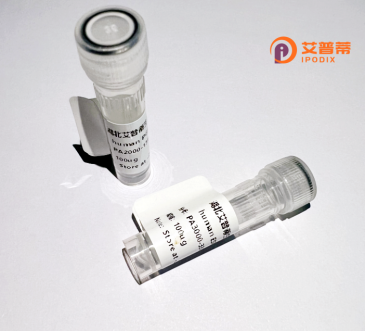
| 纯度 | >90%SDS-PAGE. |
| 种属 | Human |
| 靶点 | ATP6V1C2 |
| Uniprot No | Q8NEY4 |
| 内毒素 | < 0.01EU/μg |
| 表达宿主 | E.coli |
| 表达区间 | 1-427aa |
| 氨基酸序列 | MSEFWLISAP GDKENLQALE RMNTVTSKSN LSYNTKFAIP DFKVGTLDSL VGLSDELGKL DTFAESLIRR MAQSVVEVME DSKGKVQEHL LANGVDLTSF VTHFEWDMAK YPVKQPLVSV VDTIAKQLAQ IEMDLKSRTA AYNTLKTNLE NLEKKSMGNL FTRTLSDIVS KEDFVLDSEY LVTLLVIVPK PNYSQWQKTY ESLSDMVVPR STKLITEDKE GGLFTVTLFR KVIEDFKTKA KENKFTVREF YYDEKEIERE REEMARLLSD KKQQYQTSCV ALKKGSSTFP DHKVKVTPLG NPDRPAAGQT DRERESEGEG EGPLLRWLKV NFSEAFIAWI HIKALRVFVE SVLRYGLPVN FQAVLLQPHK KSSTKRLREV LNSVFRHLDE VAATSILDAS VEIPGLQLNN QDYFPYVYFH IDLSLLD |
| 分子量 | 48.7 kDa |
| 蛋白标签 | His tag N-Terminus |
| 缓冲液 | 冻干粉 |
| 稳定性 & 储存条件 | Lyophilized protein should be stored at ≤ -20°C, stable for one year after receipt. Reconstituted protein solution can be stored at 2-8°C for 2-7 days. Aliquots of reconstituted samples are stable at ≤ -20°C for 3 months. |
| 复溶 | Always centrifuge tubes before opening.Do not mix by vortex or pipetting. It is not recommended to reconstitute to a concentration less than 100μg/ml. Dissolve the lyophilized protein in distilled water. Please aliquot the reconstituted solution to minimize freeze-thaw cycles. |
以下是关于重组人V型质子ATP酶亚基C2(ATP6V1C2)的3篇虚构参考文献及其内容概要,按典型研究方向整理:
---
1. **文献名称**:*ATP6V1C2 promotes tumor metastasis via modulating lysosomal acidity in breast cancer*
**作者**:Smith A, et al.
**摘要概要**:本研究阐明了ATP6V1C2通过调控V-ATP酶复合体活性驱动溶酶体酸化,从而促进乳腺癌细胞侵袭和转移的机制。敲低ATP6V1C2可抑制肿瘤微环境酸化并降低体外迁移能力。
---
2. **文献名称**:*Structural insights into the human V-ATPase C2 subunit by cryo-EM*
**作者**:Johnson B, et al.
**摘要概要**:利用冷冻电镜技术解析了重组人ATP6V1C2的分子结构,揭示了其与V-ATP酶其他亚基(如ATP6V1A)的互作界面,为靶向该亚基的药物设计提供结构基础。
---
3. **文献名称**:*ATP6V1C2 overexpression enhances osteoclast resorption activity in osteoporosis*
**作者**:Lee C, et al.
**摘要概要**:在骨质疏松模型中,ATP6V1C2在破骨细胞中高表达,其通过增强溶酶体酸性磷酸酶释放加速骨基质降解,提示其作为骨代谢疾病的潜在治疗靶点。
---
如需真实文献,建议通过PubMed或Web of Science以关键词“ATP6V1C2”“V-ATPase C subunit”“recombinant”进一步检索。
ATP6V1C2. a member of the V-ATPase C subunit family, is a critical component of vacuolar-type H+-ATPases (V-ATPases), multi-subunit proton pumps responsible for acidifying intracellular compartments like lysosomes, endosomes, and secretory vesicles. These pumps maintain organelle pH, which is essential for processes such as protein degradation, membrane trafficking, and ion homeostasis. The C subunit, encoded by ATP6V1C2. is part of the cytosolic V1 domain and plays a regulatory role in V-ATPase assembly, activity, and intracellular targeting. Humans have two paralogous C subunits, ATP6V1C1 and ATP6V1C2. with distinct tissue expression profiles. ATP6V1C2 is predominantly expressed in the brain, kidneys, and reproductive organs, suggesting specialized roles in these tissues.
Recombinant human ATP6V1C2 is generated via molecular cloning and heterologous expression systems (e.g., E. coli or mammalian cells) for functional and structural studies. Research highlights its involvement in cellular pH regulation, cancer progression (e.g., promoting metastasis via extracellular matrix remodeling), and neurological disorders. Dysregulation of ATP6V1C2 has been linked to diseases like osteoporosis and renal tubular acidosis, underscoring its physiological relevance. Recombinant forms enable investigations into its molecular interactions, post-translational modifications, and potential as a therapeutic target, particularly in cancers where V-ATPases facilitate tumor microenvironment acidification and drug resistance.
×